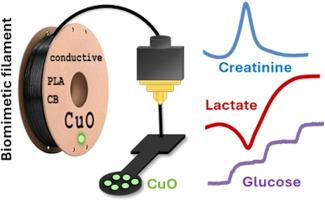Biomimetic 3D printable electrochemical filament integrated with CuO nanopowder for enzyme-free biosensing
IF 3.7
Q1 CHEMISTRY, ANALYTICAL
引用次数: 0
Abstract
3D printing technology enables the on-demand fabrication of low-cost thermoplastic electrodes, which have shown promising results in enzymatic bioassays. To fully harness the potential of 3D printing in electrochemical biosensing, this work introduces a new generation of tailor-made conductive filament integrated with a biomimetic functional material for the 3D printing of ready-to-use sensors designed for enzyme-free biodeterminations. The filament was synthesized using the solvent casting method and was composed of polylactic acid as the base, carbon black as the conductive filler, and CuO nanopowder as the artificial nanozyme. The filament was characterized using thermogravimetry, energy-dispersive X-ray spectroscopy, scanning electron microscopy, and electrochemical techniques. The as-printed sensors enabled direct electrochemical monitoring of crucial bioindicators—glucose (GLU), lactic acid (LA), and creatinine (CRE)—with exceptional sensitivity, offering limits of detection of 5.1 µM, 0.12 mM, and 1.5 µM, respectively. Moreover, the sensors exhibited high anti-interference capability and were successfully applied to the determination of the target biomarkers in blood, sweat, and urine samples. The amperometric determination of GLU was based on the conversion of integrated CuO to CuOOH, which subsequently oxidized GLU to gluconic acid. The voltammetric determination of CRE was based on the formation of copper-creatinine complexes, resulting in the suppression of the oxidation signal of electrogenerated copper. Meanwhile, LA voltammetric detection relied on the characteristic increases in the redox signals of CuO. This work paves the way for the development of accessible, point-of-need printable, and ready-to-use electrochemical biomimetic sensors for easy applications in the biosensing field.

集成CuO纳米粉末的仿生3D打印电化学丝用于无酶生物传感
3D打印技术能够按需制造低成本的热塑性电极,在酶促生物分析中显示出有希望的结果。为了充分利用3D打印在电化学生物传感方面的潜力,这项工作引入了新一代定制的导电丝和仿生功能材料,用于3D打印用于无酶生物测定的即用型传感器。以聚乳酸为基料,炭黑为导电填料,纳米氧化铜粉为人工纳米酶,采用溶剂浇铸法合成该长丝。利用热重法、能量色散x射线光谱学、扫描电子显微镜和电化学技术对灯丝进行了表征。打印的传感器能够直接电化学监测关键的生物指标-葡萄糖(GLU),乳酸(LA)和肌酐(CRE) -具有卓越的灵敏度,分别提供5.1µM, 0.12 mM和1.5µM的检测限。此外,该传感器表现出高抗干扰能力,并成功应用于血液、汗液和尿液样本中目标生物标志物的测定。GLU的安培测定是基于整合的CuO转化为CuOOH, CuOOH随后将GLU氧化为葡萄糖酸。伏安法测定CRE是基于铜-肌酐络合物的形成,从而抑制电生铜的氧化信号。同时,LA伏安检测依赖于CuO氧化还原信号的特征增加。这项工作为开发可访问的、可打印的、即用型电化学仿生传感器铺平了道路,使其易于在生物传感领域应用。
本文章由计算机程序翻译,如有差异,请以英文原文为准。
求助全文
约1分钟内获得全文
求助全文

 求助内容:
求助内容: 应助结果提醒方式:
应助结果提醒方式:


